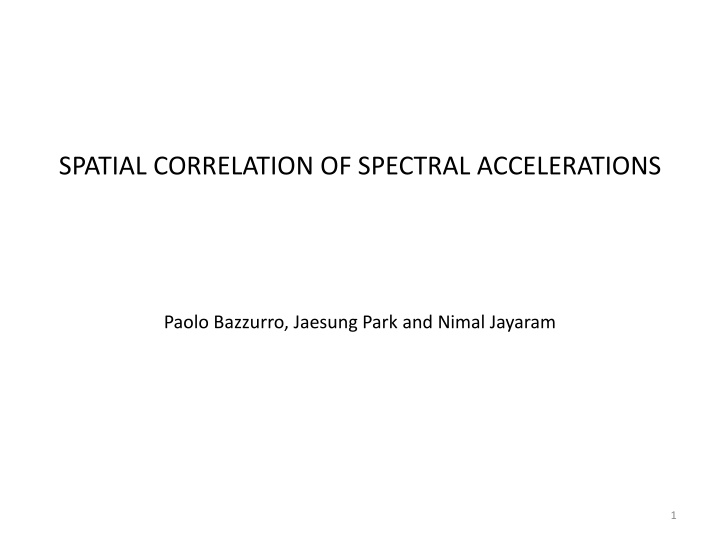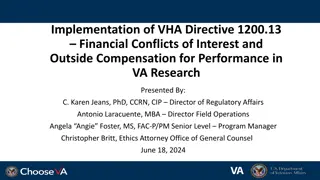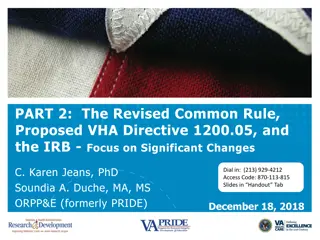
Spatial Correlation of Spectral Accelerations
Ground-motion intensities during earthquakes show spatial correlation with significant implications for risk analysis of distributed systems like buildings and infrastructure. This study focuses on estimating spatial correlation using simulated ground motions from the 1999 Chi-Chi earthquake, providing insights into ground-motion models and observed residuals from seismic events.
Download Presentation

Please find below an Image/Link to download the presentation.
The content on the website is provided AS IS for your information and personal use only. It may not be sold, licensed, or shared on other websites without obtaining consent from the author. If you encounter any issues during the download, it is possible that the publisher has removed the file from their server.
You are allowed to download the files provided on this website for personal or commercial use, subject to the condition that they are used lawfully. All files are the property of their respective owners.
The content on the website is provided AS IS for your information and personal use only. It may not be sold, licensed, or shared on other websites without obtaining consent from the author.
E N D
Presentation Transcript
SPATIAL CORRELATION OF SPECTRAL ACCELERATIONS Paolo Bazzurro, Jaesung Park and Nimal Jayaram 1
Motivation Ground-motion intensities at multiple sites during the same earthquake exhibit spatial correlation Spatial correlation is a key input parameter for risk analysis of spatially-distributed systems such as lifelines and building portfolios Researchers have used recorded ground motions to develop models for this spatial correlation We are interested in estimating spatial correlation using simulated ground motions PGA residuals from the 1999 Chi-Chi earthquake 2
Ground-motion models are used to characterize ground- motion intensities at individual sites Ground-motion models are used to predict the distribution of the ground-motion intensities as a function of magnitude, source-to- site distance, etc. for each earthquake USGS hazard map PGA with 10% probability of exceedance in 50 years = + + ln ( ) ln ( , , ,...) Sa T Sa M R T i i i 3
Observed residuals from well-recorded earthquakes = + + ln ( ) ln ( , , ,...) Sa T Sa M R T i i i i Observations of past earthquakes shows that these residuals are correlated at nearby sites, due to Common source earthquake Similar location to asperities Similar wave propagation paths Similar local-site effects = + + ln ( ) ln ( , , ,...) Sa T Sa M R T j j j j PGA s from the 1999 Chi-Chi earthquake 4
A typical approach for estimating spatial correlation Ideally, we would like to have many observations at every site pair of interest Lacking that, the following assumptions are commonly made Any pair of sites with equal separation distance within an earthquake has the same correlation (stationarity) The correlation is independent of orientation (isotropy) ( ) , = +h h Site i Site j ( ) h = 5 Jayaram and Baker (2010)
Estimation of spatial correlation The stationarity and isotropy assumptions allow us to pool many pairs of observations with comparable separation distances We can then estimate a correlation coefficient PGA s from the 1999 Chi-Chi earthquake s at two sites separated by a specified distance 6
Spatial correlation prediction model To turn these observations into a predictive model, we need: Range An equation to predict correlation as a function of separation distance, h: Empirical semivariogram A correlation range R 7
Empirically estimated ranges Source: Jayaram and Baker (2010) 8
Simulations used We use the following simulations 1989 Loma Prieta earthquake from Dr. Rob Graves 1989 Loma Prieta earthquake from Dr. Brad Aagaard 1906 San Francisco earthquake Song-Mod set from Dr. Brad Aagaard (San Francisco hypocenter) 1906 San Francisco earthquake Random HypoC from Dr. Brad Aagaard (Bodega bay hypocenter, random slip distribution) Source model Beroza (1991) and Wald et al. (1991) for Loma Prieta earthquake Song et al. (2008) for San Francisco earthquake Number of recordings 35,547 for Aagaard simulations 40,000 for Graves simulation We excluded soft soil sites and only considered spectral periods beyond 2s) 9
Correlations from simulations are comparable in some scenarios to those from recorded ground motions, larger in others 10
Revisiting the assumption of stationarity using simulated ground motions Zones are defined based on the distance from the rupture Correlations were separately estimated for each zone Sa(2s) s from the simulated ground motions 11
Correlations between residuals at near-fault sites are smaller Aagaard Song-Mod set Aagaard Random HypoC set 12
Revisiting our assumptions: isotropy? We assumed correlations were dependent only on separation distance, and not on orientation We can revisit this using directional semivariograms: Group pairs of observations by separation distance and separation orientation: += ( , ) f h , h
Directional semivariograms are reasonably similar at short separation distances Aagaard SongMod set, Sa(10s) Aagaard Random HypoC set, Sa(5s) 14
Impact of directivity effects on spatial correlation Wavelet analysis procedure of Baker (2007) used to identify pulse-like ground motions in the simulations Over 400 pulses were identified in the Aagaard s 1989 Loma Prieta earthquake simulations, and over 2000 pulses were identified in the 1906 San Francisco earthquake simulations The spatial correlation of these near-fault pulse-like ground motions are compared to that of near-fault non-pulse-like ground motions 15
Reasonably similar ranges were observed using both pulse-like and non-pulse like records in two simulation sets Aagaard SongMod set Aagaard Loma Prieta set 16
The ranges corresponding to pulse-like and non-pulse-like ground motions are drastically different for Random HypoC set Aagaard Random HypoC set The drastic difference observed in this case could be simulation specific (e.g., use of a more uniform rupture speed than proposed in the Song et al. rupture model) Further investigation is necessary, possibly using recorded ground motions, to test the impact of directivity further 17
Conclusions This study used simulated ground motions to estimate spatial correlations Near-fault ground motions (within 10km of the rupture) were seen to exhibit smaller spatial correlation The assumption of isotropy generally seems to be valid at short separation distances The effect of directivity on spatial correlation was seen to be negligible in two sets and significant in a third set Further similar investigation is necessary using recorded ground motion sets to confirm the observations discussed earlier 18







